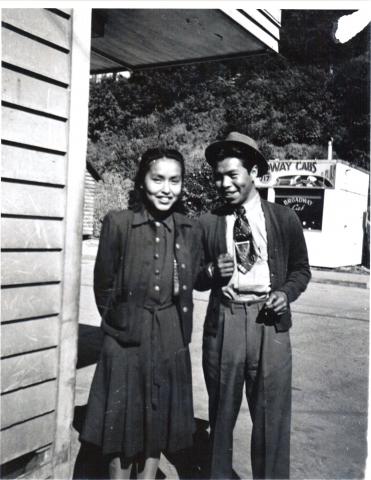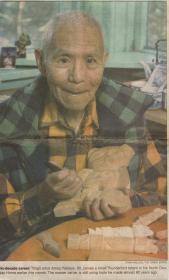Gertrude "Gerdie" Wright & Amos Wallace in Their Youth
Amos L. Wallace (1920-2004) was born in Juneau, Alaska on November 28, 1920, the son of Frank Thomas and Anna Cora Allen Thomas (1902-1970). Amos Wallace was a Tlingit Indian of the Raven Moiety, T’akdeintaan Clan of Hoonah and is often remembered for his art, being widely recognized Tlingit artist. His Tlingit name was Jeet Yaaw Dustaa.
Although Wallace was born in Juneau in 1920, his family then resided in Hoonah, and Wallace’s first six years were spent in Hoonah. Shortly thereafter Wallace’s father died and the family moved to Juneau, and a few years later Wallace’s mother married Frank Wallace in Juneau. Amos Wallace obtained his grade school education at the Indian boarding school in Skagway, a Catholic operated school known is Pius X Mission. He later obtained the remainder of his K-12 education at the Wrangell Institute, a boarding school for Alaska Native youth.
Upon completion of his K-12 education Wallace joined the U.S. Army in 1942 during the Japanese invasion of Alaska, served in Alaska, and according to Wallace’s military documentation his duties were “deck hand, radio operator, wheel watch, and winch operator.” Wallace was honorably discharged in 1945 as a Private First Class, thereafter he returned to Juneau. In 1960 Wallace married widowed Dorothy Wanamaker (1916-2006), Wallace warmly adopted her children, and the couple remained married for forty-four years, until Amos Wallace’s death in 2004. They made Juneau their home and took active roles in civic and community affairs, working to fight for civil rights as members and leaders of the Alaska Native Brotherhood and Sisterhood.
Earlier in Wallace’s youth, at age seven, he had begun to carve Tlingit art items, including model totem poles. Reportedly, Wallace’s older brother Lincoln Wallace (1919-1981) began teaching Amos to carve, and together the two carved alongside each other during their youth. Amos Wallace continued to develop his artistic talents, which soon attracted national attention beginning 1958. That year he was contracted by a New York City department store, Abraham & Strauss, to carve a totem pole in New York, the pole later being placed at the Brooklyn Children’s Museum. A few months later Wallace was asked to be a guest on the Jack Parr Show (later the Tonight Show) to speak about his art and life. Such publicity at a national level garnished Wallace numerous contracted totem carving projects, such as in 1960 being contracted to carve a totem pole at Disneyland’s Indianland. With Alaska obtaining statehood in 1959 and Wallace being a publicly known Alaska Native artist, his art work continued to grow. The Alaska State Museum’s Statehood Exhibit featured a totem pole carved by Wallace, as a centerpiece of the exhibit.
From this point Wallace’s art career continued to grow. He carved totems and large wall-plagues for a number of individuals, parks, entities, and organizations during his life. He also became a master silversmith and jeweler, carving highly artistic formline gold, silver, and copper bracelets and jewelry. Wallace was also contracted by Griffin’s-Alaska of Edmonds, Washington to carve Tlingit art pieces, such as model totem poles, plaques, bowls, and other, which Griffin’s-Alaska sold widely. His art was also sold through the Alaska Native Arts Cooperative Association, where he also became a board of director. During his later years he began teaching and apprenticing other Tlingit artists, sharing his knowledge of Tlingit art.
Amid Wallace’s art career he remained committed to his community and state affairs. He served in various capacities within the Alaska Native Brotherhood, as well as on Juneau’s Housing & Community Development Citizens Committee, the Juneau Community Education Council, and on the state’s Historic Sites Advisory Committee. In 1970 Wallace was the recipient of the Governor’s Award, the highest award given by the state to community members and artists. In 1998 the Juneau Tlingit-Haida Community Council named Wallace a Living Cultural Treasure. Wallace remained in Juneau until his passing in 2004.
The above is from Sealaska Heritage Institute, http://shicollections.org/?p=creators/creator&id=45





